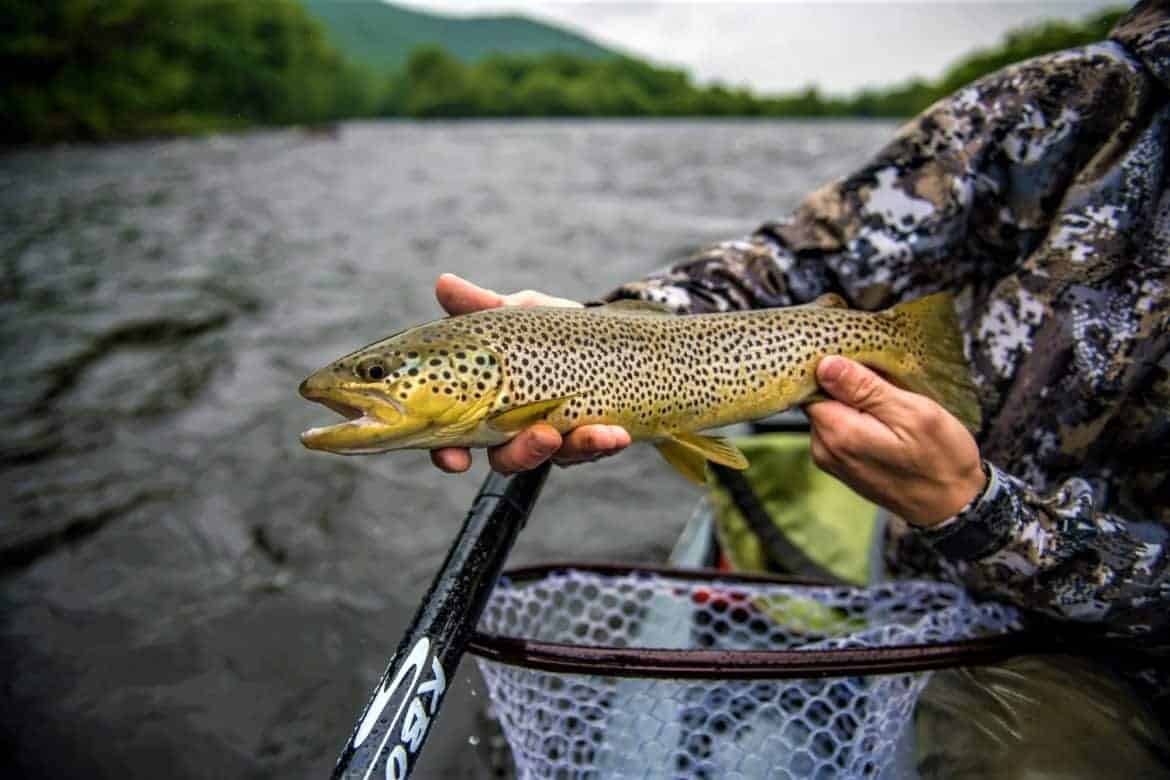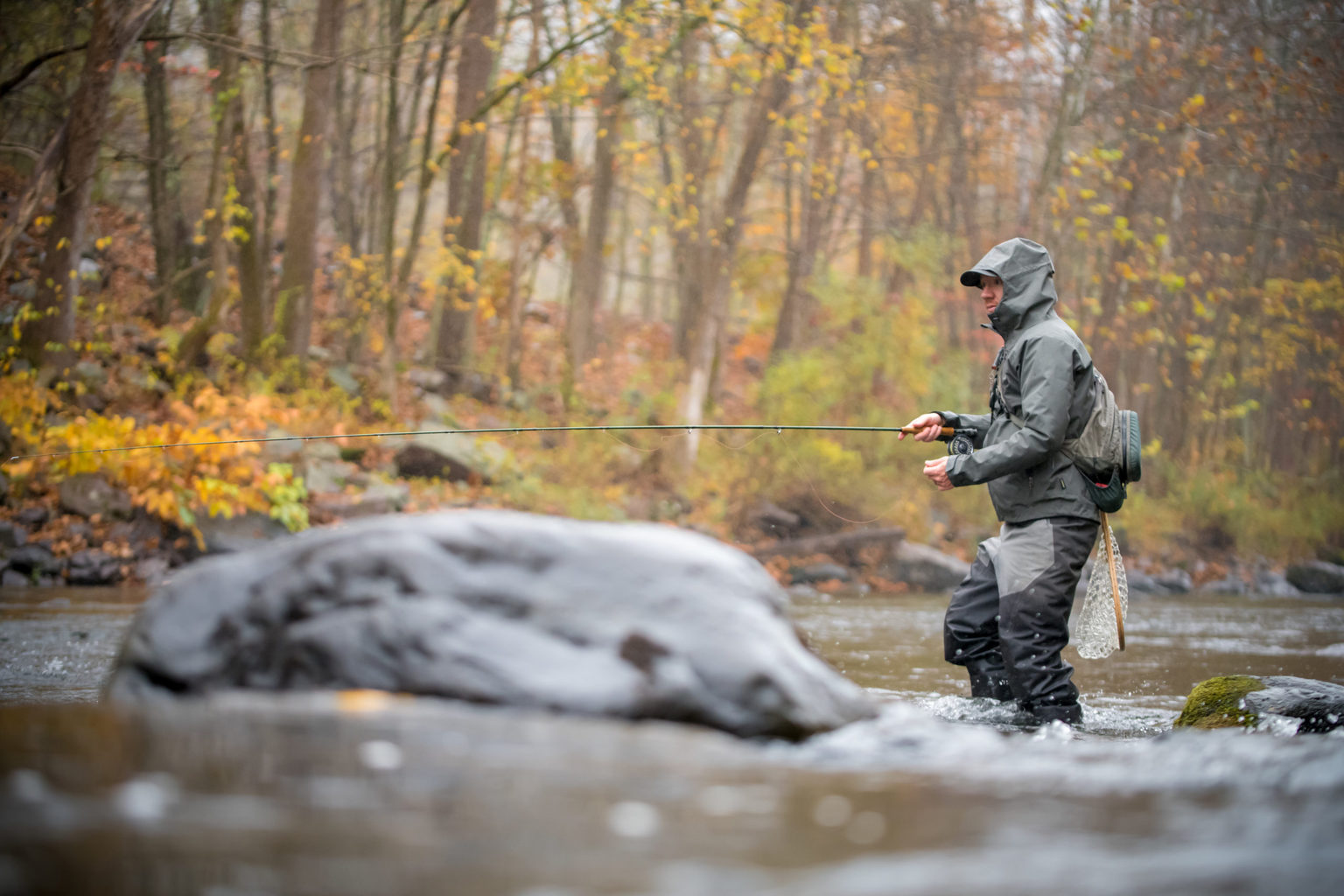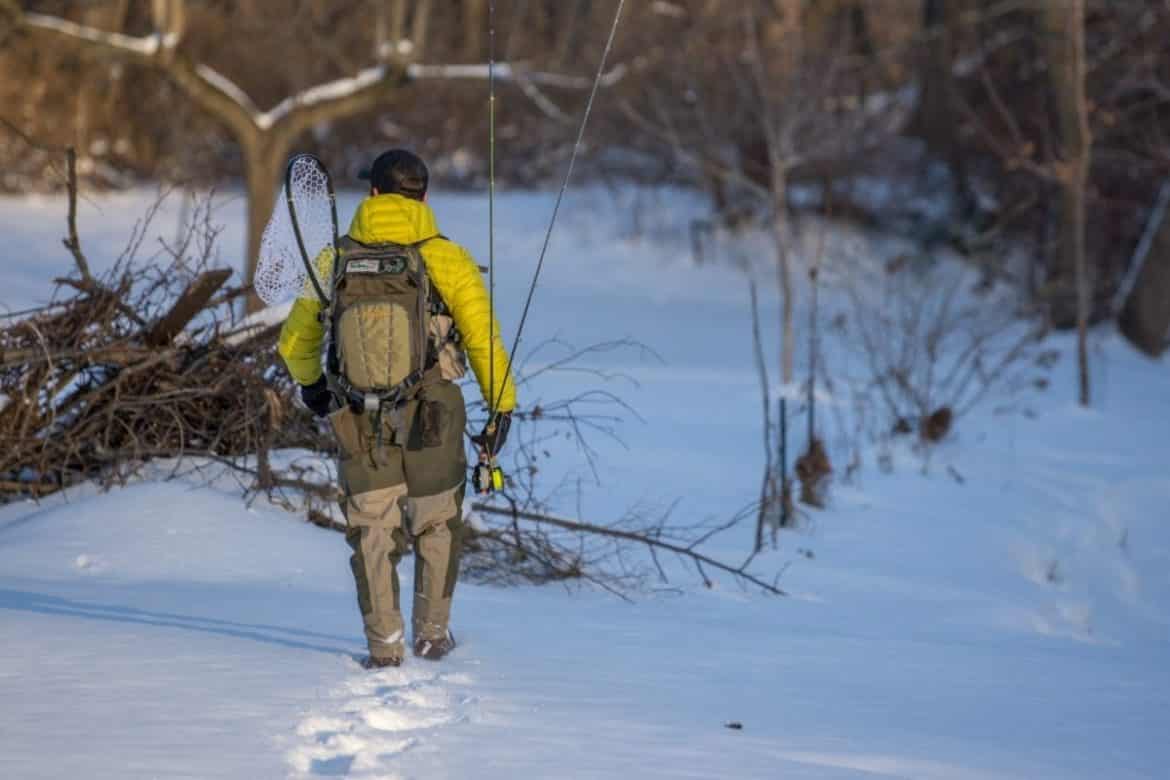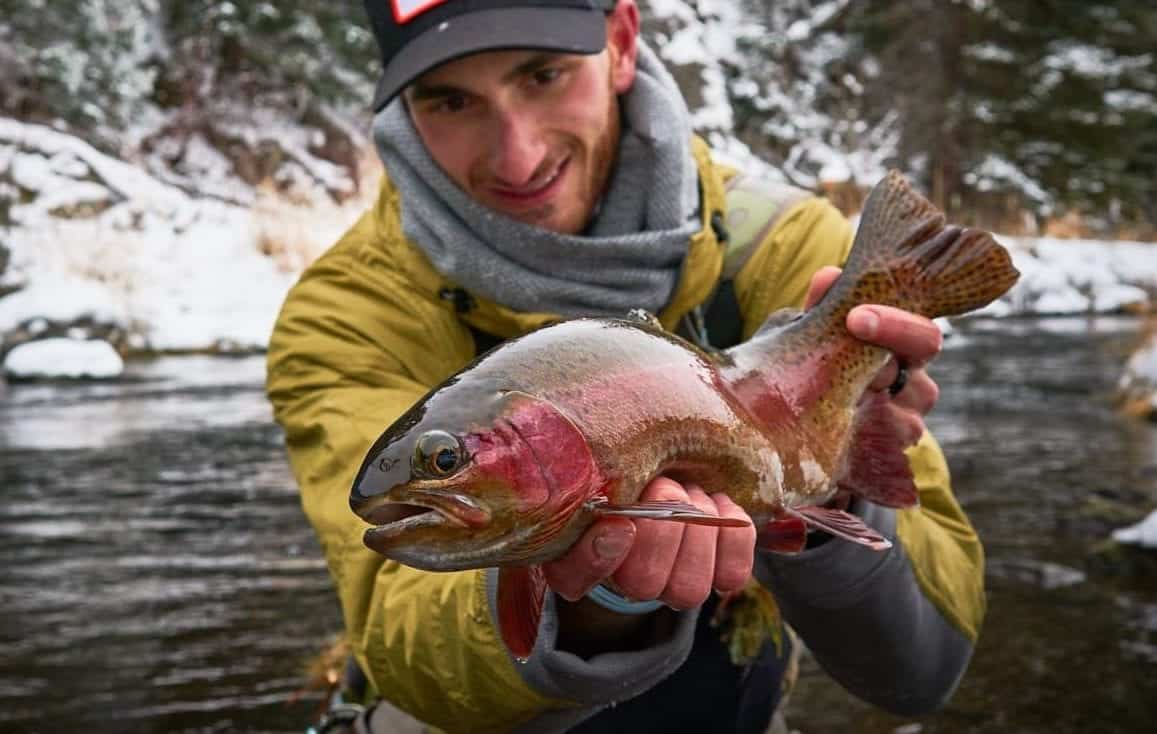Best 17 Trout Flies For Fall Fly Fishing
One of the only months that rivals the vast hatches of spring is the fall. With the migration of many winged-insects in autumn and the calm cooling temperatures throughout the day, there are always many opportunities present for avid fly anglers.
There is only a short list of 17 fly patterns that we rely on continuously to make the most of the day. When one isn’t producing or the day’s hatch is sparse, we pull another from the list and keep on fishing. We recommend that having a good supply of some of these patterns will carry you through all your fall fly fishing trips.
So here are our favorite and best fly fishing trout flies for the fall whether you’re targeting rainbow trout, brown trout, or brook trout.
Table of contents
- 1. CDC Tungsten Flashback Pheasant Tail
- 2. Woolly Bugger
- 3. Zebra Midge
- 4. Blowtorch Jig
- 5. Elk Hair Caddis
- 6. Soft Hackle Bead Head Yellow
- 7. Bead Head Soft Hackle Hare’s Ear
- 8. Shumaker’s Shimmering Minnow
- 9. Newbury’s Dirty Hipster Jig
- 10. Chubby Chernobyl
- 11. Bionic Foam Ant
- 12. Parachute Blue-Winged Olive
- 13. RS2 Emerger
- 14. Beaded Egg Fly
- 15. Tungsten Jig Bugger
- 16. Squirmy Wormy
- 17. Hare’s Ear Nymph

1. CDC Tungsten Flashback Pheasant Tail
Depth is so incredibly important with nymphs. Getting your flies down and rolling near the bottom is the optimal location when Fall days bring high water and fast currents. That’s when I turn to the CDC Tungsten Flashback Pheasant Tail to drop like an anchor with its shiny design by the weight of its tungsten bead. I have, also, surprisingly found that the color choice and profile of its nymph design is uniquely more effective than more than half of my fly box. It has outfished even my prior favorite nymphs and pupae patterns, which earns it the top spot on our list.
Recommended Reading: 15 Useful Explanations That Make Nymph Fly Fishing Stupid Simple

2. Woolly Bugger
Yeah, yeah, yeah, why a woolly bugger? Plain and simple, woolly buggers are one of the best patterns for fall and winter fishing.
Trout migrate to deep pools in the fall in preparation for winter. Along the way, they bulk up quick by becoming increasingly aggressive in their eating habits. You may think that that means easy pickin’s. Well, maybe. In warm conditions, you’ll find that. But, most of the time trout will rarely move a few feet to chase a meal in winter. So when you strip a streamer through a pool expecting one to gobble it up, don’t be surprised to come up short.

3. Zebra Midge
Midges represent over 50% of a trout’s diet in the fall and winter months. As spring approaches and temperatures begin to rise, they become even more important. Frankly, they are fantastic year-round when hatches are sparse and infrequent. Use a 4x – 6x tippet and space flies 9 – 12 inches apart.
Recommended Reading: How To Fly Fish Midge Flies

4. Blowtorch Jig
Rather than imitate naturals, this pattern is an attractor fly, which is designed to grab and hold a fish’s attention. In my own nymphing rigs, I either fish this single or coupled with another fly or two. When paired with another fly, I always make sure to put this barbless jig pattern near or at the bottom of the rig.

5. Elk Hair Caddis
With water temperatures rising to optimal levels, caddis are exploding. Typically water temperatures around 52 to 54 degrees trigger massive caddis activity. During the mid-day, feeding trout will mainly focus on the quick-swimming pupae that make their way to the surface. A simple rig of two to three soft-hackled wet flies swung through a pod of rising trout will surely get a strike.
Towards dusk, caddis will return to the water to deposit their eggs. This is your opportunity to target dozens of rising trout with few refusals. It is essential to present these Elk Hair patterns on the surface with minimal drag when your fly is pulled unnaturally. This is typically caused by your line getting pushed and pulled by the currents.
Recommended Reading: How to Fly Fish Caddis Flies

6. Soft Hackle Bead Head Yellow
When other flies fail, this soft hackle pattern has an uncanny way of surpassing our expectations. While it can be swung through pocket water and deep pools, the Caddis Soft Hackle is most effectively fished either below an indicator whether it be a foam strike indicator or a buoyant dry fly.

Buy 40 of our favorite Trout Flies.
Click the button below to shop all 40 flies we recommend for newcomers and anglers restocking. We hand-selected our best performers from this article and assembled them into one assortment.

7. Bead Head Soft Hackle Hare’s Ear
Emergers look similar in profile and have natural earthy tones, which means one pattern can nearly imitate all of them. The Hare’s Ear Soft Hackle is one of those versatile patterns. Having just one pattern for an array of different hatches allows you to save room in your fly boxes and pack light.
Emergers are not like fishing other patterns like caddis or terrestrials where a slight twitch may entice a strike. It is better to fish emergers dead-drift style, meaning make it drift down the stream like it is dead and not moving. Any excessive amount of drag and resistance will signal to trout that something isn’t right.

8. Shumaker’s Shimmering Minnow
Streams will get deep and fast with the amount of rainfall brings. And, sometimes, hatches will be delayed when water temperatures drop from cold spells, snowmelt, and or rainfall. While insects become less active, fish must still continue to feed. As a result, they will rely more heavily on easy and opportunistic meals.
Swinging a streamer through sections of a nice ‘run’ and striping in at a modest pace with timed pauses is an effective way to entice larger fish in poor and good conditions.
Recommended Reading: Fly Fishing Streamer Flies: Everything You Need To Know

9. Newbury’s Dirty Hipster Jig
Jig nymphs are probably my favorite type of nymph pattern. They have a less likely chance of snagging on the bottom and you can pack a good amount of weight on the shank.

10. Chubby Chernobyl
Grasshoppers, crickets, and stoneflies provide tons of protein for trout before the winter months. Although these meals are not prolific, trout never fail to capitalize on the errors of these large insects. Target deep pools along the banks with over-hanging vegetation by casting a few feet before the hole. I also suggest using the Chubby Chernobyl as an indicator in a hopper-dropper style rig by attaching a length of tippet to the hook eye and a nymph of your choice.
Recommended Reading: Everything You Need To Know About Dry Flies

11. Bionic Foam Ant
The water’s edge is a death trap for clumsy ants. One misstep or a gentle gust of wind can send them tumbling into the water. It is not uncommon to find fish awaiting, what we call, terrestrials along the shore. Look to target water beneath hanging tree limbs, eroded banks, and overhanging brush.

12. Parachute Blue-Winged Olive
Amidst all the chaos of larger insects hatching, trout may fool you and key in on something else — something smaller. This is what we call a masking hatch. Usually, it’s a smaller insect hatching amongst other larger flies. Trout will often only feed on the smaller insect because they are more abundant and or easier to catch.
Having a versatile emerger and adult pattern like this BWO Parachute is perfect for imitating not only Blue Winged Olives (BWO) but a wide range of tiny mayflies and midges.
There are two telltale signs that a masking hatch is occurring. Probably the most acclaimed sign is when fish seem to be rising to ‘nothing’ — because the insect is so small. And the other, when fish refuse your fly consistently. While they may refuse to take your fly for other reasons, considering all your options is always a wise choice.

13. RS2 Emerger
This pattern is a favorite of ours for tailwaters and pools of more selective trout. Typically, we fish this within our nymphing rigs or drop it off the back of a buoyant dry fly — such as a hopper or foam elk hair caddis. Our boxes are packed full of RS2’s in all sorts of tiny sizes ranging from size #18 to a #24.
Recommended Reading: Where to Find Trout In The Fall And Into The Early Winter

14. Beaded Egg Fly
During the fall spawning season of brown trout, rainbow trout will pool up below the bedding grounds and pick off the loose eggs drifting downstream. Fish eggs are packed with so much nutritional value that most trout will have a hard time letting one getaway. We always caution, never cast to spawning trout but the trout downstream are usually fair game.
Recommended Reading: How To Fly Fish Egg Flies

15. Tungsten Jig Bugger
Jigging streamers isn’t an orthodox method within the fly fishing community, but it is surprisingly effective in the right areas. In wide pools with a modest flow, we target the tail ends of the pool to swing-n-jig these micro streamers across. A slow up-and-down motion with your rod produces a ‘jigging’ action. It’s best to use a tight-line fishing technique when jigging for better line control, which is also known as ‘Euro-nymphing’.

16. Squirmy Wormy
As much as you love to hate Squirmy Wormies, they catch fish. That being said, there is a time and a place for them. Aquatic worms are a natural part of the ecosystem but truly become an important food source to trout during and after rainfall or snowmelt. Anytime the water is high and carries a hint of sediment, grab a squirmy wormy and hit the slack water. In these times of high-water trout will find refuge behind rocks, fallen trees, and in natural eddies. Squirmy Wormy flies do have a rather slow sink rate because of the drag caused by the worm material on either end. As a result, add a bit of weight when fly fishing a squirmy wormy by tying in a heavier nymph below or add some split shots.
Recommended Reading: How to Fly Fish Squirmy Wormy Flies For Big Trout

17. Hare’s Ear Nymph
Hare’s Ear nymphs can imitate a wide variety of mayflies, caddis, and stonefly larvae. They are buggy, ugly, and has all you need to fool some fall trout. Water in the fall tends to be slow and clear, so we like to go really big or really small. In this case, we tend to fish this in the smaller sizes (#16 – #20) within our nymphing rigs or dropped below some hefty dry flies.
Fly Fishing Made Easy 👍
Our Quarterly Fly Club ships 1,000’s of flies to anglers all across the United States. Receive curated fly assortments selected for the season with in-depth articles on how to fish them. Great for beginners to learn and for intermediates to discover new flies.














